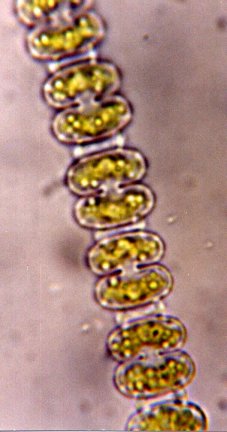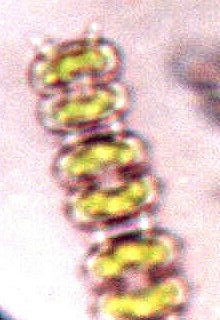The first article on desmids that form filaments showed the two genera and species that are most abundant in British waters. Species of two genera are described here, one, Onychonema filiforme (Ehr.) Roy & Biss 1886 is very rare. The other Sphaerozosma vertebratum (Bréb) Ralfs 1848 although widespread is not abundant.
Both these genera have apical processes; “The processes are sometimes very delicate, and only seen with difficulty.” (West & West 1923), they are also very small. It is obvious that I have had problems with photomicrography. High magnification is needed to see the processes which of course reduces the depth of field. The drawings have been re-drawn from the West & West monograph in order to reproduce them here.
Sphaerozosma (Figs 1 & 2): As can be seen from the drawing, the cells are loosely connected by the pair of appendages, (some authors call them processes), in the median region of the apex of each semi-cell. (Species that have appendages that are very small and more widely spread have been transferred to the genus Teilingia.) The real connecting link is the mucilage which envelopes the cells. The cells in the photograph are 22.5 µm broad, 17.3 µm long, isthmus 9 µm. One pyrenoid can be seen in each semi-cell. The filament is sometimes twisted although there is no sign of that in the ‘photo’.
Onychonema (Figs 3-5) is obviously related to Sphaerozosma. It is different from that genus in that the appendages (or processes) are longer compared to the size of the cell, the specimens in the photomicrographs have appendages about 3 µm long, these appendages are arranged so that on one side of the apex of each semi-cell one is projecting forward and the other side back. They overlap the appendages and the semi-cell of the adjacent cell. Again it is considered that mucilage helps keep the cells together in long twisting filaments. The specimens in the photo’s have cells 13.5 µm broad, 14 µm long, there is one pyrenoid in each semi-cell. There is only one other species - O.laeve Nordst 1870 found in Britain and this only once; West & West 1923 (unless it has been recorded since). In spite of the West saying both species are very rare, I have recorded O.filiforme from four sites in Sutherland, Scotland, at one site abundant.
All comments to the author Bill
Ells are welcomed.
Reference
A Monograph of the British Desmidiaceae
, 1923 by W. & G.S.West, Volume 5 by Nellie Carter. The Ray Society,
London.
Acknowledgements
I am indebted to Dr. Alan
Joyce for providing me with samples over many years, the four sites mentioned
above were sampled between 1991 and 1994.
Images

Fig.1 Sphaerozosma. |

Fig.2 Sphaerozosma. |
|

Fig.3 Onychonema. |

Fig.4 Onychonema. |
|

Fig.5 Onychonema. |
||